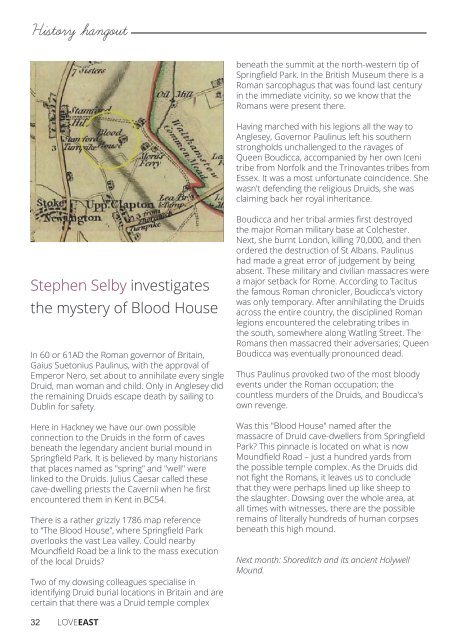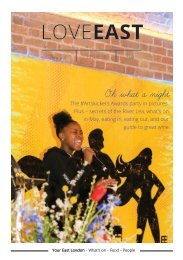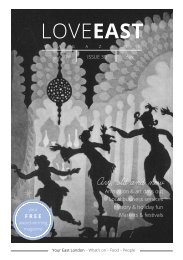February 2016
Create successful ePaper yourself
Turn your PDF publications into a flip-book with our unique Google optimized e-Paper software.
History hangout<br />
beneath the summit at the north-western tip of<br />
Springfield Park. In the British Museum there is a<br />
Roman sarcophagus that was found last century<br />
in the immediate vicinity, so we know that the<br />
Romans were present there.<br />
Having marched with his legions all the way to<br />
Anglesey, Governor Paulinus left his southern<br />
strongholds unchallenged to the ravages of<br />
Queen Boudicca, accompanied by her own Iceni<br />
tribe from Norfolk and the Trinovantes tribes from<br />
Essex. It was a most unfortunate coincidence. She<br />
wasn't defending the religious Druids, she was<br />
claiming back her royal inheritance.<br />
Stephen Selby investigates<br />
the mystery of Blood House<br />
In 60 or 61AD the Roman governor of Britain,<br />
Gaius Suetonius Paulinus, with the approval of<br />
Emperor Nero, set about to annihilate every single<br />
Druid, man woman and child. Only in Anglesey did<br />
the remaining Druids escape death by sailing to<br />
Dublin for safety.<br />
Here in Hackney we have our own possible<br />
connection to the Druids in the form of caves<br />
beneath the legendary ancient burial mound in<br />
Springfield Park. It is believed by many historians<br />
that places named as "spring" and "well" were<br />
linked to the Druids. Julius Caesar called these<br />
cave-dwelling priests the Cavernii when he first<br />
encountered them in Kent in BC54.<br />
There is a rather grizzly 1786 map reference<br />
to “The Blood House”, where Springfield Park<br />
overlooks the vast Lea valley. Could nearby<br />
Moundfield Road be a link to the mass execution<br />
of the local Druids?<br />
Two of my dowsing colleagues specialise in<br />
identifying Druid burial locations in Britain and are<br />
certain that there was a Druid temple complex<br />
Boudicca and her tribal armies first destroyed<br />
the major Roman military base at Colchester.<br />
Next, she burnt London, killing 70,000, and then<br />
ordered the destruction of St Albans. Paulinus<br />
had made a great error of judgement by being<br />
absent. These military and civilian massacres were<br />
a major setback for Rome. According to Tacitus<br />
the famous Roman chronicler, Boudicca’s victory<br />
was only temporary. After annihilating the Druids<br />
across the entire country, the disciplined Roman<br />
legions encountered the celebrating tribes in<br />
the south, somewhere along Watling Street. The<br />
Romans then massacred their adversaries; Queen<br />
Boudicca was eventually pronounced dead.<br />
Thus Paulinus provoked two of the most bloody<br />
events under the Roman occupation; the<br />
countless murders of the Druids, and Boudicca's<br />
own revenge.<br />
Was this "Blood House" named after the<br />
massacre of Druid cave-dwellers from Springfield<br />
Park? This pinnacle is located on what is now<br />
Moundfield Road – just a hundred yards from<br />
the possible temple complex. As the Druids did<br />
not fight the Romans, it leaves us to conclude<br />
that they were perhaps lined up like sheep to<br />
the slaughter. Dowsing over the whole area, at<br />
all times with witnesses, there are the possible<br />
remains of literally hundreds of human corpses<br />
beneath this high mound.<br />
Next month: Shoreditch and its ancient Holywell<br />
Mound.<br />
32 LOVEEAST


















